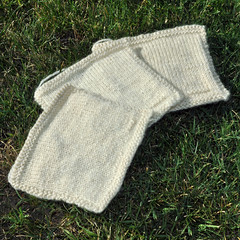Did you know there are good ways to swatch, and bad ways to swatch? I did, but ignored most of the finer points of this advice just as I ignored swatching for the most part.
I'm "frugal". I don't like to spend too much money and I don't like having "waste" at the end of the project. I'm finding this is directly in opposition to sweater-knitting which, quite frankly, takes a whole lot more yarn than you'd think at first glance. Especially if you're somewhat tall. Or busty. Or both.
Above is one bad way to swatch, which is a shocking thing to say because, hey.. it's swatching, and I don't swatch. But then again, a swatch that doesn't tell you the truth is probably worse than no swatch at all.
The point of the ever-dreaded swatch is to make sure, when you knit something as large (and expensive) as a sweater, it actually fits. The problem with the swatch above is that it involves three different needle sizes in the same swatch. It turns out that the knitting coming before, and after, actually affects the gauge of your swatch. Go figure! So doing multiple needle-sizes in one is a "no-no". I suppose you could knit it long enough to overcome the fabric's desire to conform to the area around it, but that would then negate the yarn-savings of doing it all together, and you might as well just do three separate swatches.
Which is what I finally did.
Here are three "proper" swatches. In general, I know I'm going to try and get between five and six stitches-per-inch with this yarn (assuming I properly spun the yarn to somewhere between DK and Worsted weights). Typically this is knit on needles between the US sizes 4 and 6 (which range from 3.5 to 4.0mm in diameter). It doesn't seem like a big difference, but it's amazing what those little quarter-millimeter changes can do.
The bumps you see in the lower right-hand corner of the knitting are my "Key". Four bumps for size 4 needles, five bumps for size 5 needles, and so on. This means if I want to re-measure things later, I don't have to guess which swatch is which.
Also, knowing that I was headed for 5-6 sts/in I cast on accordingly. I want to measure over four inches, so 4in x 6sts/in = 24 stitches. But I don't want to go right to the edge in my measuring, so I add a couple more. Let's say 3 stitches of stockinette on each side. And because rolling edges are a pain, another 2 in garter stitch. That gives me 34 stitches. I knit them until they were "long enough". I'd planned to make them all the same number of rows, too. But honestly I mis-counted and it wasn't worth the effort to go back and add two more rows.
The character of the cloth changes with your gauge. On size 4 needles, this cloth is dense. I'm getting 5.75-6 stitches per inch on those needles and while "bulletproof" isn't quite what I'm going to call the fabric, it's getting close.
My swatch knit on 5s is deceptive. At first glance it has 5.5 sts/inch and a lovely, drapey character. But on closer inspection, the yarn doesn't look quite as round and fluffy as my other two swatches. Likely this is owed to the fact that I'm working with handspun, and this swatch came from a very slightly different batch of yarn. If you finger this swatch, and the next one knit on 6s, the 5s swatch actually feels thinner.
The swatch on 6s does seem slightly thicker than that on 5s, but it still has very nice character. It is opaque, and not too holey. The stitches have a very nice definition, but don't feel crammed together. And it was easy to knit. I was surprised but even with the loosest tension, knitting on 4s felt like work. On 6s, the yarn flew over the needles happily.
I do have a little more yarn left and I may attempt to get a swatch on 7s. It may be slightly smaller than the others, but who knows. It still could tell me something useful.



No comments:
Post a Comment